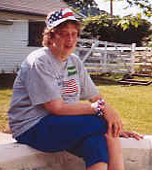Phenylketonuria (PKU)
This is a personal story shared by a family affected by PKU. (Editor’s note: Margaret is the niece of Robert Guthrie, the Father of Newborn Screening, who is mentioned in this story.)

Margaret was 13 months old when diagnosed with PKU. The earlier form of screening for PKU called the “diaper test” was being done in some doctors’ offices and well-baby clinics, but not ours. The wine diaper test was not effective until the baby was several months of age-not always perfect-and too late to prevent early brain damage. Bob Guthrie’s original inspiration to develop a test for PKU came from his son John, who was also retarded, but not because of PKU. Bob switched from cancer research to research on trying to prevent retardation. When Margaret was born in 1958, it was a complete shock to Bob that she was a PKU victim, as he graduated from the University of Minnesota and made trips to the PKU clinic here to gather frozen urine specimens!
We phoned him in Buffalo when Margaret was 9 months old, as our general practitioner diagnosed petit mal seizures at that time and referred us to his pediatrician friend who broke the news that he felt she was retarded to some degree and when she was a little older, we should take her to the University for an EEG. No hurry! How wrong-as time meant everything. Bob is the one who actually referred us to the University, but she was 13 months of age before we went in for the appointment. They did the diaper test, which confirmed the diagnosis, but it was far too late for preventing brain damage.
Actually, she didn’t sit up until about 18 months and walked at 27 months. It took about three years of medications to wipe out the petit mal seizures. Margaret was started on the PKU diet immediately at 13 months. That’s when her motor skills improved quickly. She was on the diet for about seven years when we took her off, as the medical establishment was thinking the brain is fully grown by then, and eating regular food wouldn’t hurt her. Twenty-five years later we put Margaret back on the diet. Her behavior changed radically at about age 19 to 20. She became violent, destructive, self-abusive, and screamed hysterically at things we couldn’t understand. Obviously, she was hallucinating.
Now she is calm and contented once again, and is speaking in more complete sentences with more complicated thought patterns. We should never have abandoned the diet, and now because of her and other adult PKU people, the general approach to care of PKU patients is to stay on the diet for life. Amazingly, she adjusted back to no meat, cheese, eggs, milk, etc., very easily as she certainly must feel better. Her diet supplement (powder mixed with water) is made in the U.K. She is still on some anti-psychotic drugs, minimal dosages, to help keep her behavior under control. Despite the promise of Bob’s test, we elected not to gamble on more children. We had seen several families in the PKU clinic in the early years who had two or even three children affected. The recessive inheritance (of one affected out of four, two carriers out of four, and one clear of PKU out of four) did not necessarily seem to ring true.** We opted instead to do foster care and eventually adopted three brothers for Margaret.
Margaret is considered severely to profoundly retarded. Socially, however, she can be taken to church, simple concerts, restaurants, to people’s homes for visits, and even rides a 2-wheel bike well! She enjoys music and food. Especially loves French fries and pop! She is a happy young woman, and we’re very proud of her! She can pare potatoes, load and unload the dishwasher, and open cans and packages. Though she can’t read, she’s always interested in what a package says. She lives successfully in a four-person group home eight miles from us and comes home often for visits. She goes to a cabin with us for a week every summer-loves the paddlewheel boat, fishing off the dock, and playing in the lake. She attends a Developmental Achievement Center (DAC) five days a week where they do simple crafts, sing, and go to coffee shops. She loves coffee! She can also bowl about 60 to 70 but has developed neuropathy and wears braces on both legs. She throws one foot very badly so walks best with a walker or a cane. She doesn’t complain, but long distance walking is not an option. Last fall the Sutherland Media Productions wanted to use Margaret’s image in a Howard Hughes Medical Institute Holiday Lecture Series regarding biomedical research. The book, “The PKU Story-Robert Guthrie”, has one chapter that profiles patients with PKU. Margaret is one of them. Her picture is included on p. 155. Jean Holt Koch is the author, the wife of Dr. Richard Koch who is in California, a world expert on PKU.
I pray that your sons and daughters have had miraculous things in their lives or that the screening has prevented further tragedies. Written February 2003 by Mary Lou Doll Mother of Margaret (PKU)
**Editor’s note: with autosomal recessive inheritance, if both parents are carriers for the condition if question, there is a 25% chance of having an affected child with EACH pregnancy. It is similar to tossing a coin where it is possible to get several “heads” or several “tails” in a row. Thus, it is possible or a carrier couple to have more than one affected child, even if they only have 2 or 3 children.


